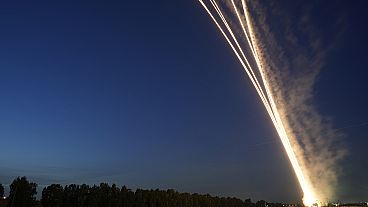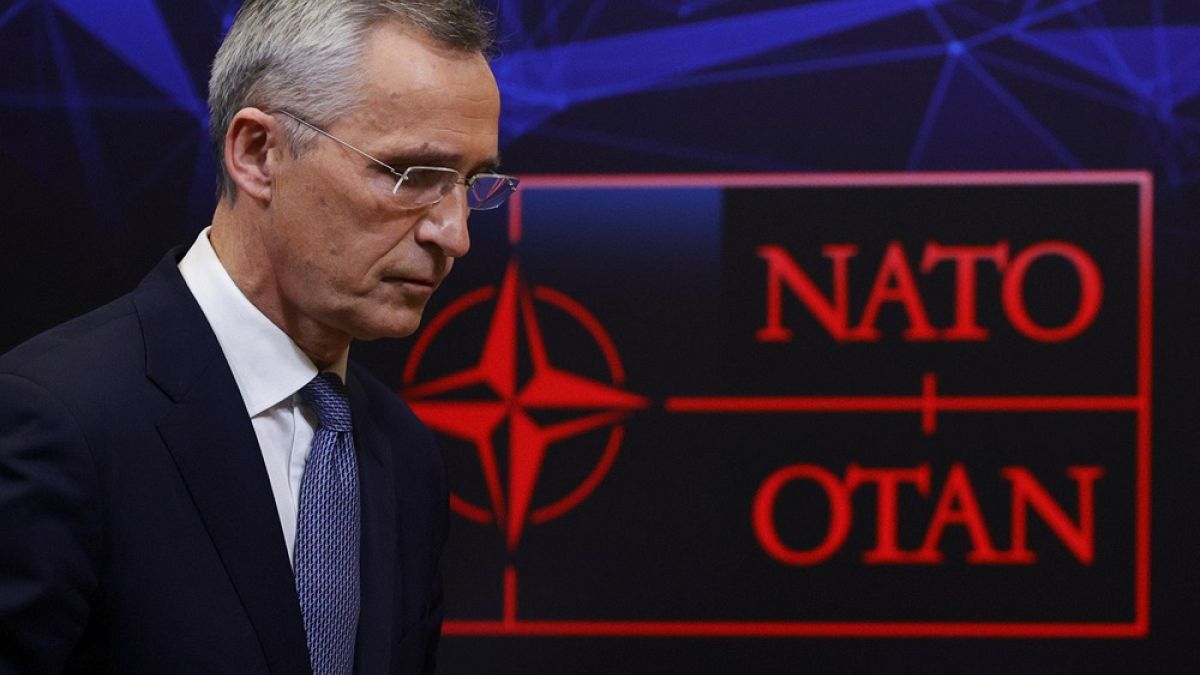Despite repeated pleas from President Zelenskyy, the West remains firm in its refusal, fearing unpredictable consequences.
In his address to British lawmakers in the House of Commons, Ukrainian President Volodymyr Zelenskyy said: "Please make sure our Ukrainian skies are safe. Please make sure you do what needs to be done."
With his impassioned plea, delivered via video link, Zelenskyy was once again calling for a no-fly zone, under which his Western allies would deploy their fighter jets to chase away Russian forces, which for the past two weeks have been bombarding Ukrainian cities.
Kharkiv, the country's second-largest city, has been ravaged by indiscriminate air attacks, leaving the streets filled with rubble and bomb craters and dashing all hopes of a fast reconstruction. In the besieged city of Mariupol, a children's hospital was bombed, killing three people, including a girl.
"How much longer will the world be an accomplice ignoring terror? Close the sky right now! Stop the killings!" wrote Zelenskyy on Twitter, accusing Russia of the attack.
So far, however, the president's calls have been rebuffed.
Even if Western countries have shown an unwavering resolve to condemn Moscow's military aggression while simultaneously unleashing a set of ruinous sanctions to cripple its military apparatus, a no-fly zone remains the Rubicon that democracies are unwilling to cross.
A relatively novel concept, the no-fly zone - or NFZ - was pioneered in the early 1990s during the Gulf War, when a coalition of 35 nations teamed up to push the Iraqi forces of Saddam Hussein out of Kuwait.
The theory is simple: a no-fly zone is a limited area over which aircraft of specific origin are not allowed to fly. It could be seen as the aerial equivalent of a demilitarised zone.
In practice, though, the concept is both complicated and risky.
In order to enforce it, surveillance and fighter jets need to be deployed to detect, identify and, if necessary, shoot down all those who violate the terms.
In 1991 the US, the UK, and France introduced a no-fly zone in northern Iraq to prevent Iraqi atrocities against the ethnic Kurdish minority living in the region, with a separate zone to protect cover for Shiite Muslims in the south.
For ten years, until the 2003 invasion of Iraq, the US and its allies flew more than 280,000 sorties, according to the Pentagon.
No-fly zones were set up in 1993 by NATO during the Bosnian war, the alliance's first engagement in an armed conflict. In 2011, they were used during the Libyan Civil War, paving the way for rebel forces to overthrow the government of Muammar Gaddafi.
Now, as Russia, undeterred by international sanctions, continues its incursion by land, sea and air, Zelenskyy is doubling down on his demands that the alliance imposes a no-fly zone over Ukraine.
"We repeat every day: close the sky over Ukraine," Zelenskyy said.
"If you don’t, if you don’t give us at least planes so we can protect ourselves, there’s only one thing to conclude: you want us to be killed very slowly."
So why don't they?
Slippery slope
Contrary to Iraq, Bosnia, and Libya, a no-fly zone in Ukraine would pit NATO against a nuclear power, Russia, with the second most powerful army in the world – something that leaders obviously want to avoid.
"I believe that all encouragements for NATO to get involved in the military conflict now are irresponsible," said Lithuanian Prime Minister Ingrida Simonyte.
In Brussels, NATO secretary-general Jens Stoltenberg underlines this red line each time a journalist brings it up.
"We understand the desperation, but if we did that, we would end up with something that could lead to a full-fledged war in Europe involving much more countries and much more suffering," he said last week.
Implementing Zelenskyy's request would require member states to deploy their fighter jets inside Ukraine's airspace to track down and chase away Russian forces. The surveillance operations would have to be constant and systemic, stretching over an enormous surface of 603 km².
Western countries would also be compelled to attack Moscow's ground-based air defence systems to protect their own planes from being shot down. This could pose significant challenges for the alliance since some of these systems might be stationed outside Ukraine, forcing NATO to strike Russian or Belarusian territory to guarantee air supremacy.
This scenario would in all likelihood lead to the open and direct confrontation that allies are so keen on avoiding and possibly trigger NATO's Article 5 of collective defence. Fears of a devastating nuclear war would go from far-fetched to plausible overnight.
"We are not part of this conflict. And we have a responsibility to ensure it does not escalate and spread beyond Ukraine," Stoltenberg said.
The risk is so high that a Polish proposal to send all its MiG-29 fighter jets to Ukraine via a US base in Germany was rejected by the Pentagon because it raised "serious concerns for the entire NATO alliance," a thinly veiled reference to a possible showdown against the Kremlin.
In Moscow, Putin has already warned a no-fly zone by any third-party would be seen as "participation in the armed conflict," although he also said the hard-hitting sanctions imposed by the West, which target everything from the Russian Central Bank to high-tech goods, are akin to a declaration of war.
The alliance's hands-on participation would give Putin an easy excuse to reframe the invasion of Ukraine as a survival war against NATO's encroachment, further galvanising his fellow citizens in favour of the military campaign.
But in Kyiv, Zelenskyy rebuffs all concerns and what-if predictions and continues to make the case for the closing of Ukrainian skies to "all Russian missiles" and "Russian military aircraft." In a scathing response to Stoltenberg, the Ukrainian president went as far as putting the blame of civilian casualties on the West.
"All the people who die from this day forward will also die because of you, because of your weakness, because of your lack of unity," the president said.
'Window of opportunity'
As the debate between capitals rages on, so does the war.
In two weeks since the invasion began, the United Nations has recorded over 1,300 civilian casualties inside the country, with almost 500 people killed. (Numbers are hard to account for given the extreme circumstances on the ground.)
"Most of the civilian casualties recorded were caused by the use of explosive weapons with a wide impact area, including shelling from heavy artillery and multi-launch rocket systems, and missile and airstrikes," the UN says, noting the real figures are "considerably higher."
It's unclear how much of this destruction has been inflicted by Russian aircraft compared to the ground and naval forces.
While Moscow has deployed warplanes and Kalibr cruise missiles to hit Ukrainian facilities, it has also sent in thousands of tanks, artillery and military vehicles to conduct major rocket and artillery bombardments, hitting residential buildings and killing scores of civilians across the country.
In turn, Ukraine has attacked the invading army using anti-tank and anti-aircraft missiles provided in record time by the United States and NATO. Kyiv's fierce resistance has managed to slow down the progress of Russia's invasion, setting the stage for a prolonged and bloody conflict.
"As the war gets more cruel and it becomes clear it will not be over tomorrow, the humanitarian costs will be higher, higher and higher," says Bruno Lété, a senior fellow at the German Marshall Fund of the United States.
"The question for NATO will be whether to stand by and watch or act."
The violence has precipitated the greatest human exodus since the end of World War II. Over two million Ukrainian have fled the country in less than two weeks and entered neighbouring states, according to the United Nations. The European Union has activated a never-used-before law to host the refugees.
The rapidly deteriorating situation, says Lété, offers a "window of opportunity" for NATO to establish a no-fly zone over the western part of Ukraine, which Russian forces have not yet reached, and thus create a humanitarian corridor that would allow the orderly and safe exit of citizens.
"It's doable right now, with low risk. We see that Russian forces are currently concentred in Eastern Ukraine and around Kyiv," Lété tells Euronews, admitting he recently changed his mind over NATO's red line.
"Given the very slow progress of the war, I don't think Russia right now has even the capacity to prevent the implementation of a no-fly zone in the East."
Even if the no-fly zone is geographically targeted, Lété notes, the operation would still require the green light from each and every NATO member state, something unlikely at the moment given the low political appetite for any endeavour that could risk an escalation and entail a commitment with no clear end in sight.
Making matters more difficult for the alliance, any attempt to impose a no-fly zone should, in principle, be backed by a resolution of the UN Security Council, as it was the case in the Bosnian and Libyan incursions.
As one of its permanent members, Russia is certain to wield its veto power to strike down any resolution that condemns the invasion or authorises a military intervention.
Alternatively, the Ukrainian government could formally invite foreign forces to enter the country as the Iraqi government did with the American-led coalition that was dispatched in 2014 to fight the so-called Islamic State.
In view of Zelenskyy's latest speeches, the invitation appears to be still on the table, despite the West's repeated efforts to turn it down.


